Back to page 1
The Design
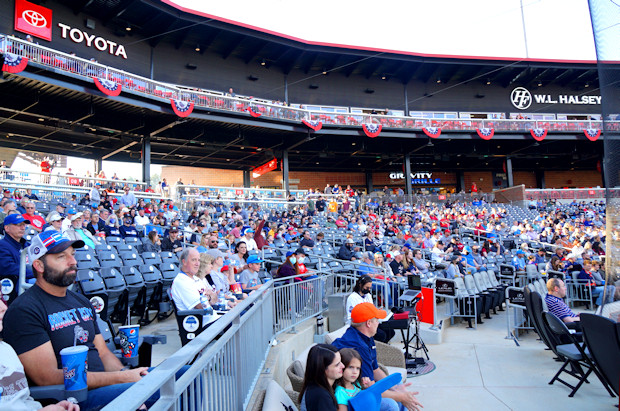
In a nutshell, I love the architecture of Toyota Field’s interior. There’s almost nothing that I would suggest be done differently. It has intimacy. It has interesting, borderline-quirky features. It’s extremely well thought-out.
And as I said, the color scheme of red and black – with seats that are dark gray (yay! No ubiquitous dark green seats!) – is beautiful. It’s different than almost any other park, and it works extremely well together.
The topography surrounding the ballpark drops decidedly from the highway interchange to the main elevation of the Town Madison parcels of land. Because of this, there is about a 15-foot drop from the concourse that runs behind the seats on the third-base side to the walkway beyond the outfield. There are steps that you can take, but there is also an elevator.
However, the elevator shaft accommodates a level one story up from the main concourse … yet there is nothing there. It’s a three-story shaft servicing just the bottom two floors.
 Locals are referring to it as “the elevator to nowhere.”
Locals are referring to it as “the elevator to nowhere.”
Now, don’t think that it will stick out like a sore thumb for all eternity. “There a lot of things we did to future-proof the building and provide for more commercial sponsorship and development,” said Jemma Radick, Experiential Designer from Populous. “That elevator allows us to add a multi-level brewpub or restaurant.” That elevator will take patrons from the bottom floor (the walkway beyond the outfield) or main concourse to the upper level of that eating establishment one day.
And it is tremendously less expensive to build the three-story elevator now – because an elevator was going to be mandatory due to the change in elevation – than tear out a two-story shaft later and replace it with a three-story one.
It just looks odd now.
But that’s where the oddities end. I can honestly say that that all of the other architectural elements in the ballpark are wonderfully functional and, shall I say, proportional to a ballpark of the Double-A level. That’s not necessarily the case at the new ballpark in Wichita, which seems a tad overbuilt for Double-A (but that’s because it was designed for a Triple-A franchise. Much more on that in our review of Riverfront Stadium).
While much of the areas beyond the outfield fences are being left in a flexible state depending on what development might be forthcoming – plus a likely pool and lazy river in right-center – the right-field corner is what people are talking about regarding Toyota Field.
Broeren said that while it was difficult to pick just one area of the park as her favorite, “I really like the berm and Rock Porch in right field. It’s a fun, casual place where people can go and mingle.”
 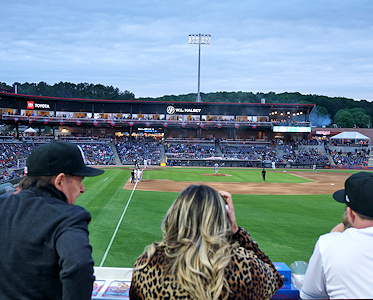 |
From a design standpoint, what makes the Rock Porch distinctive is that its upper level (there’s a bar and it’s where patrons stand or sit at tables or a drink rail — see the view in the photo above) is about 15 feet above the right-field warning track … plus it actually hangs over the playing field (see the other photo above). The area from the front ledge down to the level of the field uses the same material as on rock-climbing walls so that it mimics the look of the quarry that is only a half mile away.
The original intent was for the rock-like facing to be in play, because only balls landing on the top level would be a home run. Fair balls smacking off that uneven surface could bounce in unpredictable directions, something fans would’ve enjoyed far more than rightfielders. Well, Minor League Baseball said YES to the porch but NO to the rock-like facing being in play. They forced a fence to be put in front of the facing, where if a ball lands above the top of the fence and strikes the rock, it will be a home run, so it won’t matter if it takes a crazy bounce.
Sometimes party-poopers remove the unpredictability of balls in play, don’t they?
But there is still the aspect of the ledge hanging over the playing field. “Baseball is the only sport where we (as architects) can impact the play of the game – how much foul territory, the Rock Porch overhang, the outfield dimensions,” Jason Michael Ford, Associate Principal at Populous, told us. “And the outfield dimensions here are unlike any we’ve done anywhere else.”
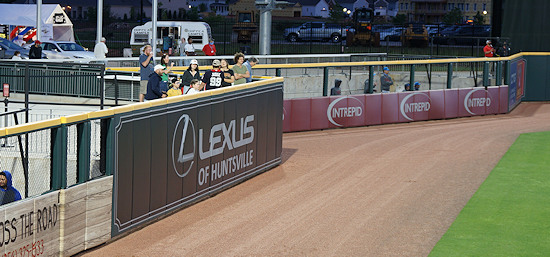
Speaking of that, there are a lot of variations in the outfield wall (see above for an example), causing the dimensions to go in and out. Too many angles for my taste. I should add that it is deeper in left-center field than in right center so that a soccer or football field can be accommodated.
Moving upstairs … the upper level of the ballpark is stupendous — except for the pressbox, which is cramped and gives writers a lousy view of the action (although the team’s media liaison Aaron Cheris is excellent at his job).
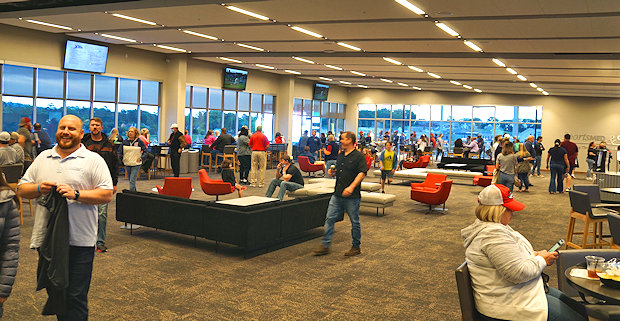
On each end of the upper story is a party deck that can be rented by groups. Toward the right-field end is one of the nicest lounges I’ve seen in the Minors. The SportsMed Stadium Club is a massive 5,000 square feet of air-conditioned opulence (see photo above), with tiered seating facing the field outside its glass walls. The view from these seats is arguably the best in the park (below).

The lounge itself was specifically requested by the city. “The mayor wanted it so that their town hall meetings can be held there,” says Sabatini. “They wanted a place that could accommodate 400 people, as they didn’t have anything downtown that could hold that many.”
When I first walked into this space, I immediately thought of the spacious lounge at Target Field in Minneapolis (also a Populous project). It also extends down the first-base line on the second level, and it is also a stunner like the SportsMed Stadium Club.
The 16 suites are certainly large enough, plus they borrow a concept from two other Populous parks (Amarillo and Goodyear) — flat patios instead of tiered seats on the outside part of the suite. This has the added benefit of allowing more light on the main concourse down below.
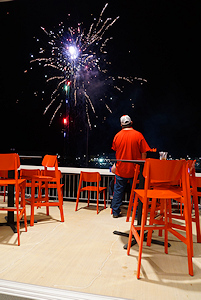 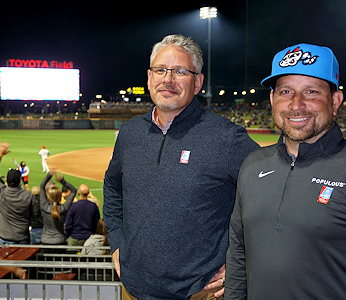 |
| The fireworks photo was taken from one of the suites, which have lovely interiors on the inner part, and flat “patios” outside. This gives the suiteholders flexibility in how they arrange the furniture — which is bright red, of course, like the roof and, well, Toyota’s logo. The other photo shows two of the team members from Populous who were responsible for the design of the park. On the left is Project Architect Josh Vogel and on the right is Project Manager Jason Michael Ford. Longtime veteran of Minor League parks Mike Sabatini (not shown) was the project designer. It is amazing how many features and programming elements the design team was able to fit into this intimate ballpark. |
And that main concourse is a beauty. It is wide and very tall, and thankfully provides a 360-degree ring around the playing field. The “concourse suites” at the back of seating sections on both the first-base and third-bases sides are well done, and the concourses are so wide that you don’t miss the space those suites occupy at all. I’d love to watch a game from one of these someday.
One attractive aspect of the “look” of Toyota Field’s interior is the judicious use of sponsorship signage. Radick was largely responsible for the signage and “wayfinding” (that’s architect speak for “signs that direct fans to what they are looking for”) in the ballpark – and she even helped with the successful pitch to Toyota to become the naming sponsor of the whole park.
“We started with a sponsorship master plan,” says Radick. “We felt that we wanted fewer sponsors so each would get more bang for their buck. We identified the places of value and did ‘distance legibility’ studies on the signs so they would be the best size.” This is a rousing success, because the logos for SportsMed, Northrop Grumman, WL Halsey and, of course, Toyota look every bit like they belong in a Major League ballpark.
And finally, the lights illuminating the field are LED and can be set to flicker on and off, and pulse in sync with the music.
There is a lot crammed into this small space … but what is it like to be a fan at a Trash Pandas’ game?
The Essentials
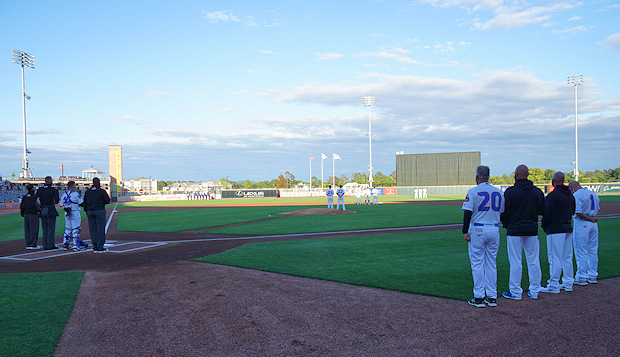
On Opening Night, the Trash Pandas delighted the fans with a surprise: Country legend Lee Greenwood sang the National Anthem, and during the 7th inning stretch, he led the crowd in singing his patriotic blockbuster God Bless the USA. “It made me emotional seeing people in the crowd getting emotional,” said Knupp the following day. “This is a military town, and people love things like that.”
 Greenwood was certainly a hard act to follow for the second home game. The responsibility of singing the Star Bangled Banner the next evening fell on the shoulders of Mary Ann Hotaling of Ms. Veteran America (see photo). She is the national ambassador for homeless women veterans. She certainly knocked it out of the park with her rendition of the Anthem. (To learn more about this worthwhile organization, click here.)
Greenwood was certainly a hard act to follow for the second home game. The responsibility of singing the Star Bangled Banner the next evening fell on the shoulders of Mary Ann Hotaling of Ms. Veteran America (see photo). She is the national ambassador for homeless women veterans. She certainly knocked it out of the park with her rendition of the Anthem. (To learn more about this worthwhile organization, click here.)
Hotaling is an Army vet, and she told us how much she appreciates the way the team has honored veterans. “Even last year when there was no baseball season, they held events like a softball game for disabled veterans,” she says. “They are just getting started here, but I am already impressed with the Trash Pandas.”
Understanding your audience is critical to delivering a gameday experience that resonates with them … and makes them want to come back. Catering to military families and all of the engineers in the area is smart, but that doesn’t mean it’s easy to do.
“Our priority is on the family, delivering affordable family entertainment,” Knupp explained. “People around here want to be with their family and relax. They want to enjoy something more affordable than going to a movie, plus in a theater you can’t talk to each other.
“We also like to play off of the name Rocket City, because we have a lot of engineers and technical people who live around here.”
So how do the families of those technical people feel about the gameday experience? Let’s take a deeper look into what it’s like, starting with costs.
Although many cars were allowed to park for free on Opening Night in an attempt to lessen a horrific traffic jam of ticket holders trying to get to the park, the normal price is $10. If you pay in advance, it’s lowered to about $6.
And I can’t mention this often enough: this is a cashless ballpark (as is the new Double-A park in Wichita). Don’t show up with a $10 bill in your hand to pay for your parking. Pay it on your phone.
I absolutely love the simplicity of how the Trash Pandas set ticket prices. It doesn’t matter if it’s a fireworks night or what day of the week it is. There is one set of prices: $25 to be in the SportsMed Stadium Club; $18 for a reserved seat anywhere on the field level ($16 if purchased in advance); $8 for General Admission – which includes sitting on the Rock Porch, which is first-come-first-served. That’s it. The pricing is just that simple.
Tickets for groups with 20 or more start at $16 and automatically generate $2 of food credit.
If you want to study the cost for various season-ticket packages, they are described on the team’s website. James and Linda Marino, who have been married 34 years, told me that they paid $950 per ticket for this season. “And the price never goes up,” James said. “Plus they only charge us $3 for parking, and they give us $5 per ticket of credit to spend on merchandise or concessions.”
This sounds like a wonderful deal, and their seats are exceptional, just behind the on-deck circle. “I got in line here at 2 a.m. in order to be one of the first to buy season tickets the following morning,” James added. The couple lives in Huntsville, and it takes them 20-25 minutes to drive to the park. They are in complete agreement that the ballpark is “excellent.” Interestingly, Linda said her father worked on the Lunar Rover at the nearby Space Center.
  |
| Here are season-ticketholders Linda and James Marino, holding the scorebook that Lee Greenwood signed while he was waiting right in front of them to sing the National Anthem. If you wait all night to buy your seats, you’ve earned the opportunity to do such things. Also shown is the Junkyard store. It’s attractive, but didn’t quite have everything we would’ve liked. |
The price of merchandise in the “Junkyard” Team Store is a little higher than I’d like to see, and is a bit higher than comparable apparel at Wichita.
Men’s button-down shirts from Antigua were $58 and $60, while Featherlite polos are $50. There weren’t enough different styles of polos, though. Adult T-shirts ranged from $25 to $32, while jersey tops were $97.
For women, there were some really attractive tank tops that were $24-$36. Three-quarter-sleeve baseball shirts were $42, and T’s were $25-$30.
Adjustable ballcaps for adults were $25 and $28, while fitted caps with nice, raised stitching were $38. There were a few ladies’ caps for $28 and caps for kids were $16-$24.
Now here’s a general observation: for a franchise with $4 million in merchandise sales – or perhaps because of $4 million in sales – I thought there wasn’t as much selection in their store as there should be. I heard several other fans express similar thoughts.
For instance, there was a fitted ballcap that I was willing to pay $38 for, so I started searching for my size. They didn’t have it, so I settled for a different design that I didn’t like quite as much. And I was there on Opening Night! Wouldn’t they want everything to be in stock then?
And the most egregious omission in the Junkyard store? There were no lapel pins of any type – that show the ballpark, that display the adorable logo, that depict the mascot, that say “Rocket City” … nothing. I asked a sales person about this because I collect such pins from every park I go to. She told me that indeed there were none, but she thought “some might be on order.” Not to have them for the first homestand at your new park isn’t good. Wichita had four different styles of pins on hand, by the way.
The other observation I have is that a lot of the merchandise said “2020” on it. I have no doubt that this is the case at every Minor League store in the country.
So what about the variety, quality and price of the concessions? On all three fronts, my expectations were exceeded. There are so many separate stands and kiosks that there really is a good variety of items – plus there are food trucks with completely different items (Vegan dishes and beignets at the two trucks when I was there) that had practically no lines, while the lines wrapped around the concourse at the team-run stands.
  |
Here’s a sampling of what’s available …
- At Banditos in the right-field corner, you can get three street tacos for $8 and house-fried chicharrons for $3;
- A number of stands have a regular hot dog for $3, a chili cheese dog for $6 and fries for $4;
- There are cheeseburger baskets for $10, and a veggie burger basket for the same price;
- The drink-only stands called Fueling Stations have domestic draft beers for $6 for 16 oz and $11 for 32 oz, imported and craft drafts for $8 for 16 oz and $13 for 32 oz, and cans of wine for $10;
- While there are run-of-the-mill chicken tenders at most of the stands, they don’t hold a candle to the tenders at Champy’s on the first-base side (photo above). Their tenders weren’t frozen a few minutes before you bought them. They are fresh, meaty, a little peppery and absolutely delicious – whether served individually (3 in a basket for $12), on a stick ($10) or on a bun with fries ($12) … and their fries were really good. They seemed to have some sort of coating, which made them crunchy and really tasty. By far, Champy’s was my favorite stand at the ballpark.
There are three concession items I want to highlight …
- The Mint Julep Chicken Sandwich Basket features a bourbon-and-mint marinated chicken breast on a bun with fries for $10;
- At the stand called Dumpster Dive (of course) behind home plate is the Dumpster Wrap (photo above). For $12, you get a quesadilla topped with chipotle aioli, fries, two hot dogs, beef chili, fried jalapeno caps, all rolled up like a wrap. I ate it and lived to tell about it (on mine, the hot dogs should have been warmer, but otherwise it was a tasty dish);
- The North Alabama Slamma, which has two beef patties, a fried mozzarella wedge, seven (yes, seven) slices of bacon and eight ounces of chili. $15.

In case you’re keeping score at home, I’m happy to tell you that this is a Pepsi ballpark.
And don’t forget that everything is cashless … which tends to make you overspend since you aren’t pulling the tens and twenties out of your billfold. You find yourself with an armload of food asking yourself “How much did I just pay for this??”
One practice by the staff that makes watching the game far more enjoyable is that ushers hold a sign at the top of a section, telling fans to wait to move down the aisle until the batter is done with his at bat. I love this. I wish this was done everywhere, because fans tend to jump up or stand at their seat right as the pitcher is winding up.
Another enjoyable feature is the sound of organ music prior to games. On Wednesdays and Saturdays, a keyboardist named Asher fills the air with the sound that is supposed to be at ballparks. Near the first-base on-deck circle (so the fans can see him), he plays a synthesizer with settings that match the sound of the organ at Yankee Stadium. On the other days of the week, the PA plays songs he’s recorded mixed in with regular Country and Rock hits.
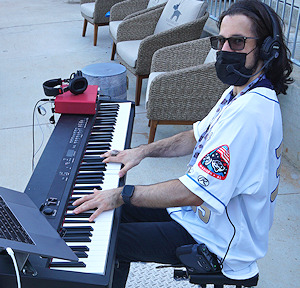 There is a play area for smaller kids beyond third base, and inflatables for bigger kids will be available beyond the outfield once COVID restrictions are completely removed.
There is a play area for smaller kids beyond third base, and inflatables for bigger kids will be available beyond the outfield once COVID restrictions are completely removed.
The sound system is perfect – not too loud and not too soft. The scoreboard in right field is top of the line and (unlike in Wichita) it provides a good amount of game information.
In summary, there is no doubt that this is a fun place to attend a game. The focus on families is evident – with things of interest to engineers and those in the military — and things are kept light-hearted and, at times, appropriately zany. As you’ll read in our Wichita review, they take a different approach.
Summary

There is a lot going on there on those couple of acres occupied by Toyota Field. “We program everything here that’s in a Major League ballpark,” says Populous’ Ford. “But it’s a real challenge to do it all for $46 million,” which was the budget here. I think they pulled it off.
When you look at logistics, you’d have to conclude that everything is lined up for the Trash Pandas to be extremely successful: location, ballpark, coming development, etc. You need to keep in mind, though, that it takes people to pull all of these pieces together to complete the puzzle.
| The Executive Branch |
 |
| On the team website, there are two names under Executive Leadership: Garrett Fahrmann and Lindsey Knupp. Below, Knupp has to “face the music” to explain parking snafus — and she pulls it off with a smile. |
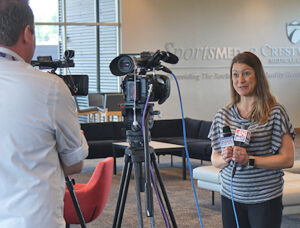 |
Obviously, you need a leader setting the right example and getting everyone to march in the same direction. Executive VP and GM Garrett Fahrmann was a ballplayer and coach back in my home state of West Virginia, before going on to work for the Potomac Cannons and Fresno Grizzlies. Most recently, he ran operations for the Lehigh Valley IronPigs, frequent award winners for ops, including the Larry MacPhail Award, recognizing the top promotional effort in the sport.
Fahrmann credits his staff for the successful launch of the Trash Pandas. He pointed out a couple during our interview.
When it comes to “learning the building” (as he puts it), “we’d be lost without Jason Marriott, who’s our Director of Facility Maintenance. He is amazingly talented and makes the operation work. He knows where every outlet and pump is located, and how to fix them. He built our Christmas light show last year, using three tractor trailers of Christmas lights. It attracted 27,000 cars.
“I got him to move here from California. He is the best facilities maintenance guy in Minor League Baseball.”
Fahrmann is also quick to credit his number-two in command (and it’s a shame that there aren’t more women in executive positions in baseball, although that’s changing): “We couldn’t have done this without Lindsey (Knupp), who I brought from Lehigh Valley. She oversees all the entertainment and she is without a doubt a rockstar for on-field promotions.”
Her experience has served her time and time again. On the day after the park’s first game, in which traffic was snarled for miles and fans couldn’t get into the parking lots, she gamely faced two TV cameras (one for broadcast, one for Facebook Live) at the same time while holding two microphones, and calmly answered questions about the fiasco and clearly articulated the steps being taken to make things better. She is both a pro and a delight.
And using precision that would make the military folks in the crowd proud, she manages all of the pregame activities according to a gameday sheet that is broken down into 20-second timeslots!
Knowing your audience and exceeding their expectations – added to the fact that Toyota Field is a winner – should ensure that the rocket-powered Trash Pandas reach even greater heights.
Tell us what you think of this review or of Toyota Field in the comments box below.
A tremendous article! A life-long baseball fan and previous season ticket holder of former Huntsville Stars team, I must say you rocked this review!! Thank you. Great insight and detailed overview. I love our Trash Pandas!
Re: The “cramped” pressbox, it’s not cramped because there are no daily newspapers nor “beat writers” to cover the team.